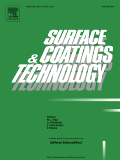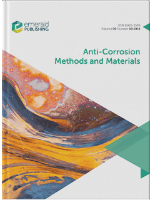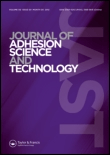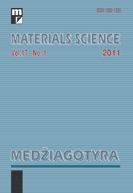
Journal of Coatings Technology and Research
Scope & Guideline
Elevating Coatings Research for a Sustainable Tomorrow
Introduction
Aims and Scopes
- Coating Materials and Formulations:
The journal publishes research on a variety of coating materials, including polymers, ceramics, and composites. It highlights advancements in formulations that enhance performance characteristics such as durability, adhesion, and environmental resistance. - Surface Engineering and Modification:
Research on techniques for modifying surfaces to improve their properties is a core focus. This includes studies on superhydrophobic surfaces, self-cleaning coatings, and anti-fouling technologies. - Corrosion Protection:
A significant area of research is dedicated to coatings designed for corrosion resistance. This includes the development of novel materials and systems that provide long-lasting protection for metals and other substrates. - Thermal and Fire Resistance:
The journal explores coatings with enhanced thermal stability and fire-retardant properties, addressing safety in various applications, particularly in construction and transportation. - Sustainability and Eco-Friendly Coatings:
There is a growing emphasis on sustainable practices within the coatings industry, including the development of bio-based and low-VOC coatings, as well as research on recycling and eco-friendliness. - Smart and Functional Coatings:
The journal also covers emerging technologies in smart coatings that respond to environmental stimuli, such as temperature or humidity, and multifunctional coatings that combine several desirable properties. - Nanotechnology in Coatings:
Nanotechnology is increasingly utilized in coatings to enhance properties such as strength, flexibility, and barrier performance. The journal publishes significant findings related to the incorporation of nanoparticles into coatings.
Trending and Emerging
- Eco-Friendly and Sustainable Coatings:
There is a notable increase in research focused on developing eco-friendly coatings, including bio-based materials and low-VOC formulations, in response to environmental regulations and consumer demand. - Self-Healing Coatings:
Self-healing coatings are gaining traction for their ability to repair damage autonomously, enhancing the longevity and durability of coated surfaces. This is particularly relevant in high-performance applications. - Smart Coatings with Functional Properties:
Research into smart coatings that respond to environmental stimuli, such as temperature or moisture, is on the rise. These coatings offer potential applications in various fields, including construction and consumer goods. - Nanostructured and Nanocomposite Coatings:
The use of nanotechnology in coatings is increasingly prevalent, with studies focusing on the incorporation of nanoparticles to enhance mechanical, thermal, and protective properties. - Antimicrobial and Antifouling Coatings:
The demand for coatings with antimicrobial properties is growing, particularly in healthcare and marine applications, to prevent biofilm formation and enhance hygiene. - Advanced Characterization Techniques:
Emerging methods for characterizing coating properties, including advanced imaging and testing techniques, are becoming more common, enabling deeper insights into coating performance and behavior.
Declining or Waning
- Traditional Solvent-Based Coatings:
Research on conventional solvent-based coatings is declining as industries move towards more environmentally friendly alternatives. The focus is shifting to waterborne and UV-curable formulations. - Simple Aesthetic Coatings:
There is a reduced emphasis on coatings whose primary function is aesthetic. The trend is moving towards multifunctional coatings that provide additional benefits such as anti-corrosion and self-cleaning properties. - Single-Function Coatings:
The traditional approach of developing coatings for a single function is waning. The current trend favors multifunctional coatings that can address multiple challenges simultaneously. - Non-Bio-Based Materials:
The interest in non-bio-based materials for coatings is decreasing as there is a stronger push for sustainability and the use of renewable resources in coating formulations. - Research on Coatings for Niche Applications:
Studies focused on very niche applications (e.g., coatings for specific, less common industries) are less frequent, with broader applicability and general industry relevance being prioritized.
Similar Journals

SURFACE & COATINGS TECHNOLOGY
Unveiling the Science Behind Surfaces and CoatingsSURFACE & COATINGS TECHNOLOGY is a premier academic journal that has been at the forefront of research and innovation since its inception in 1986, diligently published by Elsevier Science SA. With an impressive range of studies focusing on surface and coatings technologies, the journal has established itself as a leading platform within the fields of Chemistry, Condensed Matter Physics, and Materials Science. Notably, it holds a distinguished Q1 ranking in multiple categories, showcasing its relevance and high impact in the academic community. Furthermore, it is recognized for its rigorous peer-review process and is indexed in esteemed databases, maintaining its strong position with a ranking of #17 in Surfaces, Coatings, and Films. Although the journal does not currently offer open access options, it continues to be a crucial resource for researchers, professionals, and students seeking insights into cutting-edge developments and applications in the domain of surface engineering. With a commitment to advancing knowledge across these disciplines, SURFACE & COATINGS TECHNOLOGY is an essential read for anyone interested in the latest trends and technologies shaping the industry.

International Journal of Corrosion and Scale Inhibition
Transforming Knowledge into Action Against Material DegradationInternational Journal of Corrosion and Scale Inhibition (ISSN: 2305-6894, E-ISSN: 2305-6894), published by VSEROSSIISKAYA ASSOTSIATSIYA KORROZIONISTOV, is a distinguished open-access journal dedicated to advancing knowledge in the critical fields of corrosion science and material degradation processes. Established in 2012, this journal serves as a vital platform for researchers, professionals, and students aiming to explore innovative solutions to corrosion-related challenges across diverse industries. Located in the Russian Federation, it boasts commendable rankings, placing it in the Q2 category for both Materials Chemistry and Metals and Alloys, signifying its significant impact within the scientific community. With a robust Scopus ranking—a commendable 40th out of 176 in Materials Science for Metals and Alloys and 120th out of 317 in Materials Chemistry—the journal highlights its pivotal role in disseminating research that shapes the future of material durability and sustainability. By fostering open access to scholarly work, the journal ensures that critical findings are accessible to a broad audience, thereby promoting knowledge sharing and collaboration in the quest to mitigate corrosion and enhance material performance.

ANTI-CORROSION METHODS AND MATERIALS
Transforming Corrosion Prevention Through ResearchANTI-CORROSION METHODS AND MATERIALS, published by EMERALD GROUP PUBLISHING LTD, is a leading journal in the fields of chemical engineering and materials science, focusing on innovative methods and materials for corrosion prevention and control. With its ISSN 0003-5599 and E-ISSN 1758-4221, this esteemed journal has been contributing to the academic community since its inception in 1954 and continues to be relevant through 2024. Despite its Q3 ranking in both Chemical Engineering and Materials Science categories, the journal plays a critical role in disseminating valuable insights and advancements, catering to a diverse audience of researchers, professionals, and students. Although the journal does not offer open access options, it remains a significant resource for those seeking to enhance their understanding of corrosion methodologies and to implement best practices in various industrial applications. With the recent Scopus rankings reflecting its impact, ANTI-CORROSION METHODS AND MATERIALS stands as a pivotal element of scholarly discourse in mitigating corrosion challenges in modern materials.

Corrosion Science and Technology-Korea
Connecting scholars to drive advancements in corrosion technology.Corrosion Science and Technology-Korea, published by the CORROSION SCIENCE SOC KOREA, is a pivotal journal dedicated to the exploration and advancement of knowledge in corrosion science, particularly within the context of materials performance and maintenance. Established to foster innovation and collaboration among scholars in South Korea and beyond, this journal focuses on areas such as electrochemistry, metal alloys, and surface coatings, catering to a diverse audience of researchers, professionals, and students in materials science and chemistry. Despite its current quartile rankings, including Q4 in Electrochemistry and Q3 in various materials-related categories, the journal aims to enhance its visibility and impact in the scientific community by publishing high-quality research and reviews. With its ISSN 1598-6462 and E-ISSN 2288-6524, Corrosion Science and Technology-Korea is committed to contributing to the understanding and mitigation of corrosion issues, thereby promoting sustainability and longevity in engineering applications.

Protection of Metals and Physical Chemistry of Surfaces
Connecting Theory and Application in Materials ChemistryProtection of Metals and Physical Chemistry of Surfaces is a prominent academic journal published by MAIK NAUKA/INTERPERIODICA/SPRINGER, which provides a specialized platform for researchers and professionals in the fields of materials chemistry, metals and alloys, organic chemistry, as well as surfaces, coatings, and films. With an ISSN of 2070-2051 and an E-ISSN of 2070-206X, the journal is recognized for its rigorous peer-reviewed content and comprehensive coverage of innovative research addressing the latest advancements in material protection and surface chemistry. As of 2023, the journal has been categorized in the Q3 quartile across several relevant fields, highlighting its increasing influence within the scientific community. Although the journal is relatively niche, its open access model encourages wide dissemination of knowledge, fostering collaboration and advancements within its core disciplines. Research published in this journal plays a crucial role in not only enhancing theoretical understanding but also facilitating practical applications in various industries, thereby underlining its importance for students, researchers, and professionals alike.

Frontiers of Materials Science
Empowering Researchers with Open Access to Materials ScienceFrontiers of Materials Science is a groundbreaking journal dedicated to exploring advanced materials and their applications within the ever-evolving landscape of materials science. Published by HIGHER EDUCATION PRESS, this journal offers a crucial platform for scholars and practitioners seeking to disseminate innovative research findings that foster interdisciplinary collaboration. Since its inception in 2011, the journal has enjoyed a notable Q2 ranking in the category of Materials Science (miscellaneous) as of 2023, positioning it among the noteworthy publications in the field with a Scopus rank of #222 out of 463. While predominantly published in China, the journal is committed to open access principles, allowing global accessibility to cutting-edge research. With its comprehensive coverage spanning materials synthesis, characterization, properties, and applications, Frontiers of Materials Science not only serves as a repository for academia but also bridges the gap between research and industry, making it an indispensable resource for researchers, professionals, and students alike.

Surface Innovations
Exploring the Frontiers of Surface ScienceSurface Innovations, an esteemed journal published by Emerald Group Publishing Ltd, serves as a crucial platform for researchers and professionals working within the fields of Materials Chemistry, Process Chemistry and Technology, and Surfaces, Coatings and Films. Launched in 2013, this journal has garnered attention for its commitment to advancing knowledge and innovation, holding a distinguished Q3 ranking in multiple categories as of 2023. With a focus on the latest methodologies and applications in surface science, Surface Innovations not only facilitates the dissemination of cutting-edge research but also encourages interdisciplinary collaboration among scientists and engineers. While not an open-access journal, it offers numerous options for accessibility to engage a wide array of audiences, making it a valuable resource for those looking to expand their understanding and expertise in this rapidly evolving field. The journal's consistent inclusion in high-ranking Scopus categories further underscores its academic impact and relevance.

JOURNAL OF ADHESION SCIENCE AND TECHNOLOGY
Elevating Knowledge in the Dynamic World of Adhesion Science.Journal of Adhesion Science and Technology is a distinguished publication within the fields of Chemistry, Materials Science, and Engineering, published by the reputable Taylor & Francis Ltd. Since its inception in 1987, the journal has been pivotal in advancing the understanding of adhesion mechanisms, technologies, and applications, boasting a conversion period extending to 2024. With a commendable impact factor and rankings placed in the Q2 category across various relevant domains, including Mechanics of Materials and Materials Chemistry, it offers a robust platform for scholars and practitioners alike. While currently not an open-access journal, it provides multiple access options, ensuring that vital research in adhesion science remains accessible to those dedicated to innovation and practical improvements in material interactions. This journal not only promotes empirical research but also encourages interdisciplinary collaboration, making it essential reading for researchers, industry professionals, and students eager to contribute to this dynamic field.

Materials Science-Medziagotyra
Unlocking Potential Through Open Access ResearchMaterials Science-Medziagotyra is a prominent peer-reviewed journal dedicated to the field of materials science, published by Kaunas University of Technology in Lithuania. Since its transition to an Open Access model in 2012, it has facilitated broad dissemination of research findings, enhancing accessibility for researchers and professionals worldwide. This journal is indexed in Scopus and has consistently contributed to the academic community with a focus on innovative materials and their applications, ranking in the Q3 category of Materials Science (miscellaneous) as of 2023. With the responsibility of synthesizing substantial research from 2008 through 2024, Materials Science-Medziagotyra aims to bridge gaps in material research while fostering collaboration among scientists, students, and industry leaders. Its commitment to quality and rigor in scientific discourse underscores its relevance and importance in advancing the field.

JOURNAL OF IRON AND STEEL RESEARCH INTERNATIONAL
Uncovering Breakthroughs in Metals and AlloysJOURNAL OF IRON AND STEEL RESEARCH INTERNATIONAL, published by Springer, stands as a leading peer-reviewed journal in the fields of Materials Chemistry, Mechanics of Materials, and Metals and Alloys. With a strong focus on interdisciplinary research, the journal contributes significantly to the advancement of knowledge in these sectors, reflected in its impressive ranking, including Q1 status in Metals and Alloys for 2023. The journal is not only a crucial resource for critical insights into the properties and applications of iron and steel but also serves as a vibrant platform for researchers and professionals to disseminate novel findings ranging from fundamental science to practical engineering applications. With a broad scope that has evolved since its inception in 1996 and maintains a consistent commitment to high-quality research, this journal is essential for students, scholars, and industry experts aiming to keep abreast of the latest developments and innovations in the iron and steel domain.